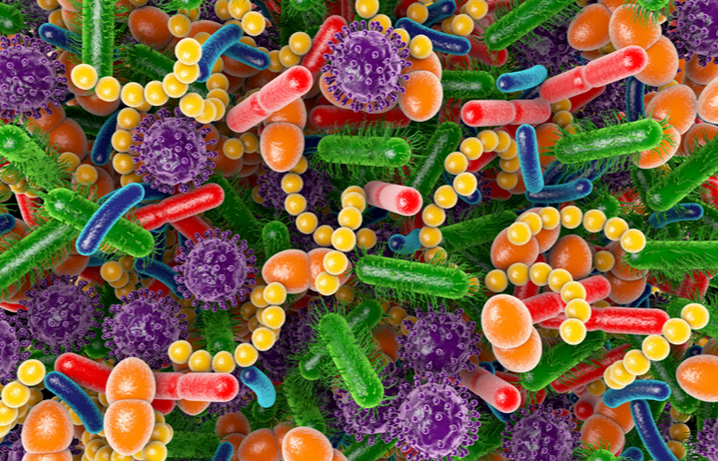|
Acupuncturist Philippa Summers delves into the world of healthy bacteria - microbiome - and gives some helpful insights and tips as to how this can benefit us along with a delicious saurkraut recipe to help us along. Did you know that your body contains roughly as many bacterial cells as human cells? Along with viruses and fungi, and their collective DNA, they make up our microbiome. The microbiome varies hugely from person to person and plays a crucial role in determining our health. There is a whole eco system living on your skin and within you, in your respiratory tract, your reproductive tract, in breast and other tissue, but primarily in the intestines – the gut microbiome. Among them are vitally important beneficial microbes that help to keep the disease-causing pathogens at bay, while also enhancing and interacting with many of the vital internal processes that work to keep us well. The Benefits of a Healthy Gut Microbiome A healthy gut microbiome has benefits that extend throughout the body and is considered by some to be equivalent to an additional organ, such is its importance. It plays a crucial role in helping to maintain and support metabolic function, immunity, plus cardiovascular, respiratory, reproductive and menopausal health, as well as helping with sleep, mental well- being and brain function. It is an area of intense research, with more being discovered all the time. The scope of its influence cannot be overstated. A healthy gut microbiome is anti- inflammatory and helps to combat the development and progression of a whole range of chronic health issues and to reduce infections throughout the body, helping in the fight against antibiotic resistance. Type 2 diabetes, obesity, kidney disease, Parkinson’s, atherosclerosis, high cholesterol, hypertension, dementia, urinary tract infections, respiratory infections, vaginal infections, asthma, allergies, autoimmune diseases, IBS, IBD, some cancers...the list goes on... have all been shown to have an association with an unhealthy balance in the gut microbiome. It is the subject of ongoing research to determine the processes and balance of cause and effect between disease and the microbiome. A High Fibre Diet supports the Microbiome Our environment, where we live, who we live with, how we interact with our environment but particularly our diet has a huge influence on the microbiome, and for each of us our microbial fingerprint will be unique and changing dynamically all the time. A poor low fibre diet of refined carbohydrates like white flour, white rice and particularly simple sugars will encourage inflammation and take the balance of good bacteria to bad inan unhealthy direction. A healthy high fibre diet on the other hand will help to support the community of beneficial bacteria, which ferment more complex carbohydrates that we cannot otherwise digest, into nutrients with anti-inflammatory and metabolic health benefits. The beneficial bacteria lie mainly in the colon at the far reaches of our intestines and to feed and support them we need a diet where the carbohydrate portion of what we eat can pass through the upper reaches of the intestines to the colon without previously being completely broken down. Simple and refined carbs get broken down too high up in our guts but high fibre complex carbohydrates (wholegrains, vegetables, nuts, seeds and fruit) make it all the way to where they are needed. Aim for a wide variety of colourful plant foods including herbs and spices to aid digestion, and of course include proteins and healthy fats for a balanced diet. We feed these bacteria and they in turn feed us with the beneficial by-products of their meal. Think good housemates - you provide the healthy ingredients, and they cook up a feast! The healthy foods we provide them with are the prebiotics, the healthy ‘bugs’ are the probiotics. Choosing Probiotic Foods and Supplements Some species of these healthy bacteria will have established themselves as long term residents of our gut, beginning at birth and supported early on by breastfeeding. We can augment this existing population by eating fermented foods containing other beneficial live bacteria, or for convenience and maybe for specific health issues by taking them as supplements. To reap the benefits, we need to choose those that are alive and can survive through the upper reaches of the gut all the way to the colon as many cannot survive the acid of the stomach. How our individual microbiome interacts with our own metabolism and diet is complex and more in-depth studies that take a personalised approach are the subject of ongoing research, one of the largest being the Zoe PREDICT studies. A peek at these studies will show you how complicated a field it is. People with a histamine sensitivity may not tolerate probiotics and care should be taken by people with bowel conditions like IBS and IBD. Deciding which strains are most beneficial is a complex subject which varies from person to person and according to the health issues being addressed, and I suspect is obscured by the commercial nature of supplements and the influence on research. Lactobacillus and Bifidobacterium are the most widely recommended in supplements, with many species and strains of each offering different benefits. A little more of that below in relation to women’s health and gut health but to go into more detail is beyond the scope of my experience or this blog. If you prefer to take supplements in my opinion Optibac are a reliable good value brand and provide a simple useful guide with formulas for a variety of situations: every day, after taking antibiotics, for women’s health including during pregnancy and for gut health. Symprove receives wide recommendation but is much more expensive and is limited to a single multi-strain formula. I am not suitably knowledgable to offer any wholeheartedrecommendations but those are a couple of reliable options. You can eat fermented foods as well or instead. For Women’s Health including fertility and menopause Lactobacillus species support a healthy vaginal microbiome where they help to keep disease causing yeasts and bacteria at bay, by maintaining a favourable protective acidic environment. From the research so far, implantation and reduced incidence of early pregnancy loss are also supported when the predominant species in the uterus are Lactobacilli. They are of benefit when taken orally, even for colonising the reproductive tract. Lactobacillus species can also be helpful at alleviating some of the symptoms of menopause via the two-way interaction between oestrogen levels and the gut microbiome. Yoghurt, kefir and Sauerkraut are all high in Lactobacillus species and other lactic acid bacteria. For Gut Health For people with gut issues like IBS and IBD I would recommend seeking guidance from a dietary or nutritional specialist. Some of the otherwise healthy prebiotic foods can contribute to symptoms, and some probiotic strains can be helpful while others may exacerbate symptoms. Probiotic Fermented Foods For general health benefits why not try a range of different live unpasteurised probiotic foods such as kefir, yoghurt, kombucha, kimchi, miso or sauerkraut to see which you like and which suit you? Or try making your own. They can be more potent than probiotics supplements and much cheaper, too, and all have different microbial profiles and benefits. Some ferments like kefir and kamboucha contain a range of yeast and bacteria while others like yoghurt, sauerkraut and kimchi are predominantly bacterial. Additionally, as they have fermented over a period of time the fermented product will contain high amounts of more easily digestible nutrients that are a by-product of the fermentation process. Making your own fermented foods If you fancy making a home-made ferment you can try the simple sauerkraut recipe below. Incidentally, I was surprised to learn that sauerkraut, despite its German name, originated around 2000 years ago in China and came to Europe in the 1600s. Making Kimchi, a spicy Korean ferment, is similar and there are plenty of recipes online. If you really want to get into ferments then I recommend Fermentation by Asa Simonsson which covers a whole range of fermented foods and drinks including vegan dairy, or check out the many websites and blogs on fermenting. Sauerkraut Recipe You will need a container in which to ferment the veg before transferring it to smaller jars
for storage, and you will also need weights to hold the veg below the surface of the liquid while it ferments. You could use a large wide necked jar with a lid but you will need to keep an eye on it and keep releasing the gas that will build up inside. Or you may wish to buy a fermenting jar or a crock pot which allow the gas to release automatically. Some come with weights, others don’t. Ingredients 1kg finely chopped white or red cabbage (you can substitute some of the cabbage with grated carrot, beetroot and apple to make a total of 1kg veg) 15g sea salt Optional spices: 1 tbsp chopped garlic/ginger 1 tsp caraway seeds, chili flakes, peppercorns, seaweed etc Method • Place the veg, salt and spices in a large clean bowl mix well and massage with your hands for 5 mins. Leave for 5 mins. • Massage and squeeze again for about 20-25 mins until you have plenty of juice and the veg has softened. • Pack into the fermenting jar or crock, add the weight so that all the veg is completely submerged in the briny liquid. This is very important as the fermentation will spoil if the veg is exposed to the air. • Put on the lid and leave at room temperature to ferment. The fermenting jars have a valve, the crock has a sunken rim that you fill with water so the gases release automatically. Keep checking that the water level around the rim is above the notch in the lid. • Leave for anything from 5 days to 4 weeks depending on the room temperature and how sour you like it. I leave mine for about 10 days. As the sauerkraut ferments is becomes more acidic which most bugs can’t tolerate and you’ll end up with a tasty ferment rich in acid tolerant Lactobacillus. The result should be a crisp, slightly sour, flavoursome kraut. If it becomes mouldy, slimy or smells rotten then something has gone wrong, so discard. Pack into clean jars, pressing the veg below the surface of the liquid and store in the fridge. Keeps for weeks, months according to the experts but I’ve never left it that long. Great in a sandwich, salad or as a meal accompaniment.A word of warning - as your body adjusts to fibre and probiotics you may find you are a bit more flatulent, but it should settle down after a few days, start with a little and build up. In any case, a little every day is better than larger quantities less frequently.
1 Comment
|
AuthorBlogs from the WNT team. For our blogs from before June 2020 please see individual profile pages - it's a good way to get to know practitioners too. Archives
June 2024
Categories
All
|
|
Visit us - by appointment only please - in the office block in the Access Self Storage premises at 443 Norwood Road, London, SE27 9DQ
[email protected] Phone - please contact practitioners directly, or if not in a rush you can leave a message for us to call you back at 07931876931. |



 RSS Feed
RSS Feed
